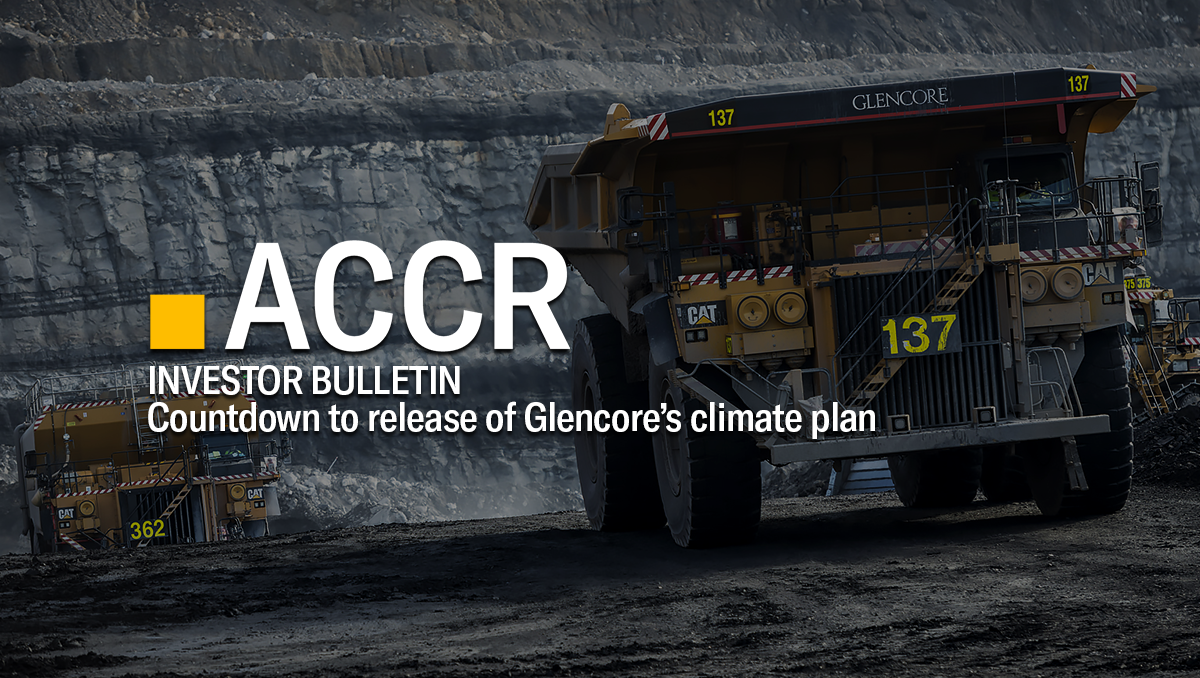Investor Insight Investor Bulletin: Countdown to release of Glencore’s climate plan
Last year, Glencore plc faced investor unrest with over 30% of its shareholders voting against its Climate Plan. Glencore’s inability to successfully navigate energy transition risks has been an escalating concern for investors, and the company must demonstrate it has a credible plan to manage the vast emissions from its coal business. Glencore intends to publish its updated Climate Action Transition Plan (Climate Plan) later this month.
This Climate Plan is critical as it sets the basis for the company's climate strategy over the next three years and beyond. It is also expected to address the emissions related to the acquisition of Teck Resources Limited's (Teck) metallurgical coal business, Elk Valley Resources (EVR).
ACCR will undertake a thorough review of the Climate Plan when it is released.
In the meantime, ACCR has identified five key actions that Glencore should take in the upcoming Climate Plan.
Commit to using the International Energy Agency’s (IEA) coal-specific Net Zero Emissions (NZE) pathway instead of the current general fossil fuel pathway. This reflects Glencore’s fossil fuel production composition, which is 99% coal.
- Glencore’s most recently adopted emissions pathway was the IEA NZE pathway for all fossil fuels, including coal, oil, gas and bioenergy, despite its Industrial portfolio being predominantly coal-based.
- Glencore’s current approach allows it to reduce its coal production more slowly than the NZE coal-specific pathway recommends, thus making its decarbonisation strategy less accurate and less ambitious.
- The IEA's NZE coal pathway requires a significantly accelerated reduction in coal use compared to the reductions when considering all fossil fuels (see chart below).
Select a representative baseline year that complies with the Greenhouse Gas (GHG) Protocol standards. Glencore uses 2019 as its baseline year, which as a year with higher than normal emissions, allows it to exaggerate the impact of any reductions. For example, claiming a 27% emissions reduction in 2020 - significantly surpassing in just one year the 2026 goal of 15%[1].
- Glencore’s 2019 baseline year had an unrepresentative amount of coal production, and has not been adjusted to reflect the relinquishment of contracts at the Prodeco coal mine.
- There could be regulatory or other risks associated with choosing such an obviously unrepresentative and high base year from which to measure all emissions reductions from.
- Introduce a 2030 target in line with a Paris-aligned coal pathway. The nine-year gap between Glencore’s 2026 and 2035 targets surpasses the recommended maximum five-year interval for a credible climate plan.[2]
Glencore only partially meets CA100+’s assessment criteria for medium (2027-2035) and long-term (2036-2050) targets, due to the targets not being aligned with the Paris Agreement.[3]
Adopt credible emissions reduction pathways for the EVR coal mines to be acquired from Teck. ACCR analysis demonstrates that planned run rates for EVR metallurgical coal mines substantially exceed the IEA's NZE metallurgical coal pathway. When assessing the current climate disclosures for these coal mines, ACCR notes:
- EVR’s mid-term Scope 1 and 2 emissions reduction targets are undefined, with a noticeable lack of a Scope 3 target.
- The currently disclosed forward coal production volumes from EVR’s coal mines are significantly misaligned with the NZE pathway for metallurgical coal.
- Provide investors with clear Industrial segment coal capital expenditure (capex) guidance, distinguishing between expansionary and sustaining capex for coal.
After reviewing Glencore’s recent 2023 preliminary results, it has become clear that Glencore no longer distinguishes its capex guidance into expansionary and sustaining capex for both metals and energy portfolios.
This is not aligned with investors' expectations for capex disclosures. At the 2023 AGM, 29% of Glencore’s shareholders voted in support of a shareholder proposal for Glencore to provide details of how the Company’s capital expenditure allocated to thermal coal production will align with the Paris Agreement. While Glencore discloses an array of categories for 2023,[4] it does not disclose the amount of spending attributable to coal expansions or extensions. For investors, this inability to distinguish between what is expansionary vs sustaining capex for coal makes it more difficult to ascertain Paris alignment. Glencore also does not meet any CA100+’s assessment criteria for capital allocation.[5]
As demonstrated in the chart below, the amount of expansionary capex on coal in FY23 and the guidance for FY24-26 is now unclear. ACCR expects the company to rectify this change in the Climate Plan and to provide clear information on how its coal capex aligns with the Paris Agreement.
For more information to assist in assessing Glencore’s upcoming Climate Plan, you can access ACCR’s notes on the key areas of potential improvements to the Climate Plan and notes on the Teck EVR coal acquisition.
View PDF of Countdown to release of Glencore’s climate plan | 19/03/24
Please read the terms and conditions attached to the use of this site.
The 15% reduction target is based on the holistic fossil fuel emissions pathway. This reduction target is 30% in a coal-specific pathway. ↩︎
Climate Policy Initiative, What makes a transition plan credible?, 2022, p5. https://www.climatepolicyinitiative.org/wp-content/uploads/2022/03/Credible-Transition-Plans.pdf ↩︎
Climate Action 100+, Company Assessment: Glencore https://www.climateaction100.org/company/glencore-plc/ ↩︎
Glencore, 2023 Preliminary Results, p29, Feb 2024.https://www.glencore.com/.rest/api/v1/documents/static/bcd27c43-43cf-4592-8557-83597fd5bf35/20240221+GLEN+2023+Preliminary+Results+presentation.pdf ↩︎
Climate Action 100+, Company Assessment: Glencore https://www.climateaction100.org/company/glencore-plc/ ↩︎
